From Assessment to Activity: Using Your BAL Report to Reduce Bushfire Ris
Ensuring Bush Fire Defense Via Proper BAL Record Analysis
In the world of bush fire security, the precise analysis of Bushfire Strike Level (BAL) reports stands as a keystone for guarding residential or commercial properties against the terrible effect of wildfires. With environmental aspects and building features playing considerable functions in figuring out the degree of danger, a complete understanding of BAL ratings comes to be essential. Nevertheless, the actual significance lies not simply in understanding these records but in deciphering them properly to formulate tailored fire defense strategies. By delving right into the significance of BAL report analysis, we discover a realm where informed choices lead the course towards reinforcing home security and resilience in fire-prone regions.
Understanding Bushfire Attack Level (BAL)
In the world of bushfire defense, understanding the Bushfire Attack Level (BAL) is critical for guaranteeing reliable reduction approaches. BAL is a system utilized to determine the prospective threat a structure might deal with from a bushfire. It considers elements such as the type of plant life, the incline of the land, the Fire Threat Index, and the Fire Intensity Index. Recognizing the BAL score of a property is essential for property owners, contractors, and policymakers to implement appropriate procedures to safeguard against bushfire dangers.
Significance of BAL Record Evaluation
An essential facet in bushfire security preparation includes the comprehensive evaluation of BAL records to assess the possible threats and establish proper reduction strategies. BAL records offer crucial details about the potential impact of bushfires on a residential property based on various variables such as plants type, distance to prospective fire dangers, and slope of the land. Analyzing these records with precision is vital in developing reliable bushfire defense measures tailored to the specific threat profile of a home.
Executing Fire Defense Steps
Applying reliable fire protection actions is vital for guarding residential or commercial properties in bushfire-prone areas. Among the main methods to improve fire security is by creating defensible room around buildings. This involves clearing up combustible plants, such as completely dry fallen leaves and branches, within a particular radius of the building. In addition, setting up fire-resistant roof materials can assist decrease the danger of ashes firing up the roof covering during a bushfire. Effectively preserved seamless gutters and screens are also necessary to avoid particles buildup that could sustain a fire.
Additionally, having a well-kept and adequate water supply, such as a storage tank or swimming pool, can help firefighters in their initiatives to safeguard the building. BAL Report. Overall, applying a combination of these fire security steps can dramatically boost the chances of protecting buildings throughout bushfire events.
Mitigating Threats in Fire-Prone Locations
To strengthen properties versus bushfire threats, a strategic emphasis on mitigating risks in fire-prone locations is crucial. One important aspect of risk mitigation is maintaining defensible room around residential properties by removing flammable vegetation, making sure ample spacing in between frameworks and trees, and utilizing fireproof landscape design techniques.
Additionally, building or retrofitting buildings with fire-resistant materials and making certain proper upkeep of roofs, seamless gutters, and external cladding can significantly enhance the property's resilience to bushfires. Creating and practicing a bushfire emergency visit this web-site strategy with all passengers, consisting of emptying treatments and communication strategies, is likewise vital in mitigating dangers successfully. By embracing a positive strategy to run the risk of mitigation in fire-prone locations, homeowner can much better protect their possessions and improve general bushfire preparedness.
Ensuring Residential Property Safety And Security and Durability
Ensuring the safety and resilience of homes in fire-prone areas calls for an unfaltering commitment to robust precautionary steps and strategic preparation. Home safety starts with applying efficient measures to decrease fire dangers. This includes maintaining a defensible space around the residential property by removing flammable plants, making sure correct upkeep of roofing systems and rain gutters, and making use of fire-resistant building products. Normal upkeep of firefighting devices, such as hoses and automatic sprinkler, is likewise important to building durability.
Durability, on the other hand, involves the capacity of a residential or commercial property to recover and endure from a bushfire. This can be boosted with the setup of coal guards on home windows and vents, making certain that entry factors for embers are reduced. In addition, having a well-thought-out emptying strategy and exercising it on a Learn More Here regular basis can significantly raise home strength. Working together with next-door neighbors and regional fire authorities can additionally boost the safety and security and durability of buildings in fire-prone areas. By proactively resolving these aspects, homeowner can better protect their properties and enjoyed ones from the risk of bushfires.
Conclusion
In conclusion, making certain bushfire protection with appropriate BAL record evaluation is essential for recognizing the degree of danger postured by bushfires and implementing essential fire protection steps. By reducing risks in fire-prone areas and guaranteeing home security and resilience, people and areas can better get ready for and respond to bushfire occasions. It is critical to focus on fire precaution to shield lives and building in these high-risk environments.
In the world of bush fire protection, the meticulous analysis of Bushfire Attack Degree (BAL) records stands as a cornerstone for safeguarding properties against the destructive effect of wildfires (BAL Report). Comprehending the BAL score of a residential property is critical for residential property proprietors, policymakers, and building contractors to implement ideal procedures to secure versus bushfire hazards

BAL reports give essential details concerning the potential impact of bushfires on a building based on different aspects such as plant life kind, distance to possible fire hazards, and slope of the land (BAL Report). Generally, implementing a mix of these fire defense procedures can dramatically raise the possibilities of guarding homes during bushfire occasions